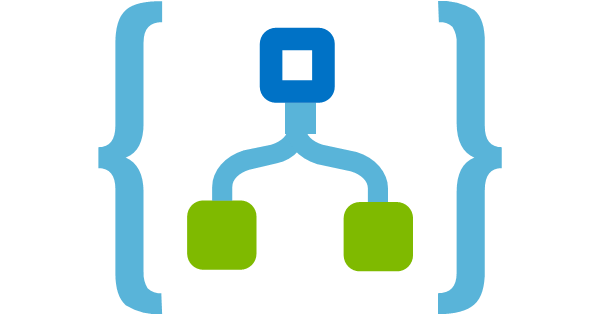
Enterprise Integration using Microsoft Logic Apps and Cognitive Service API’s
Microsoft iPaaS
The Gartner definition of Integration Platform as a Service (iPaaS) is a cloud service that provides a platform to support application, data and process integration projects, usually involving a combination of cloud-based applications and data sources, APIs and on-premises systems. [1]
Microsoft Azure provides different technologies which enable developers to build, integrate and rapidly deploy robust application solutions. Logic Apps is a vital aspect of their iPaaS offering that facilitates both Cloud and Hybrid Cloud Integration. [2] [3]
Logic Apps
Microsoft Logic Apps is a fully managed iPaaS (integration Platform as a Service) solution which allows developers to build highly scalable workflows and will automatically scale to meet demand. Logic Apps is based on the Workflow Definition Language and provides a way to simplify, automate and integrate scalable workflows into the cloud. Logic Apps modernizes and democratizes data integration for Software as a Service (SaaS) making use of cloud-based connectors for Salesforce, Office 365, Twitter, Dropbox, Google services, and several others.
To fully understand and appreciate how Logic Apps functions as part of Microsoft’s iPaaS offering there are a few fundamental concepts that a developer will need to understand. First, Logic Apps provides a graphical method (using the Azure Portal or Visual Studio) to model business processes as a series of steps referred to as a Workflow. Second, Managed Connectors are utilized across the public and private cloud to facilitate connectivity to thousands of applications and services. Microsoft provides access to over (150) Out-of-the-Box (OOB) connectors used to execute workflows and process new and existing data. API connections facilitate one-time authentication, authorization, re-use, differentiate between connection configurations and provide a portal for API management. [4]
Some managed connectors act as Triggers and initiate Actions (up to 6000 per min) based on specific criteria such as the arrival of an e-mail, an alert, a change to a Virtual Machine or a tweet on Twitter where someone mentioned a topic using a specific (#MSE238) hashtag. Each step following a triggered workflow is referred to as an action and maps to an operation on a managed connector or a custom API. [4.1]
Enterprise Integration Diagram using Logic Apps
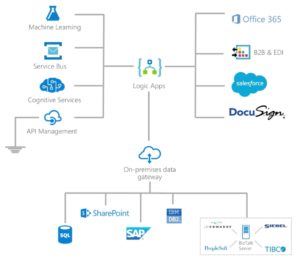
Logic Apps makes use of several popular connectors like the Office 365 Outlook connector to design workflows that utilizes email and calendar features within Office 365. For example, the Office 365 Outlook connecter might be used to send an email using programmed credentials when a new object is created in Salesforce (trigger), resulting in the transmission of an email (Action) to interested parties. [5]
Cognitive Service API’s in Azure
While Logic Apps do facilitate rapid deployment of scalable workflows and B2B/EDI connectivity for Disaster Recovery, the focus of this blog is to discuss how Logic Apps makes use of Cognitive Computing using Cognitive Service API’s in Microsoft Azure. As discussed during our lecture on “Cloud Platforms for the Cognitive Era”, Dr. Jeff Welser stated that augmenting human intelligence using Cognitive Computing will revolutionize how companies do business in the future. In particular, he discussed how IBM and other organizations are investing in Cognitive Computing, Cloud Computing and AI research. The purpose of Cognitive divisions are to develop intuitive AI solutions through the use of Neural Nets, Pattern Matching, Deep Learning and the Inferencing of data to facilitate hyper-growth and scale. At Microsoft, their approach to data science and artificial intelligence is to utilize Analytic Engines that run on Big Data Stores (Cloud + On-Premise). Next, they utilize unique data assets (Bing Search), and combine them with proprietary and open source algorithms. By funneling all of this information through Data Science Tools like HD Insight, and Azure Machine learning, Microsoft is able to create packaged Cognitive Service API’s and their Bot Framework.
An example of a Cognitive Service API is Microsoft’s Text Analytics API, which allows application developers to detect sentiment, extract key phrases, determine topics of discussion and even detect language from applications that solicit customer feedback. [6]
Example 1: Positive Experience
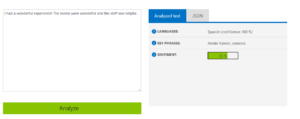
Example 2: Negative Experience
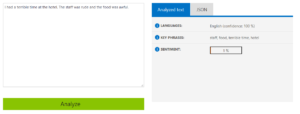
Emotion, Face and Language API
During the creation of your workflow, Logic Apps allows you to link your workflow to Cognitive Service API’s in Azure to process cognitive information. Microsoft has created several Cognitive API’s that allow developers to gather additional information about information that act as input.
Imagine for a moment that in addition to the Text Analytics API, a system provided a video or photograph of the customers experience. A workflow can be created to assess a video or photograph using the Emotion, Facial Recognition and Language API’s. The Emotion API evaluates facial expression in an image (as input), and returns a confidence value across a set of emotions for each face in the image, as well as placing a box around the face using the Face API for which the assessment was performed. [7] [8] E.g. Uber utilizes the Face API to verify the identity of drivers. [8.1]
Figure 1: Using Photographs as Input
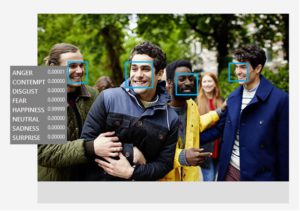
The Emotion API can also evaluate videos and interpret the body language of an individual across several frames in the image to get an overall sense of their disposition or mood from one frame to another. Combined with the Video API and Translator Speech API, Logic Apps can automatically smooth and stabilize shaky video [9] and allow developers to add end-to-end, real-time, speech translations to their mobile, desktop, and web applications. Based on your individual needs, workflows can be created to provide partial transcriptions as someone speaks, provide partial text translations, text translations, and/or text-to-speech (audio) translations. [10]
Figure 2: Videos as Input
(http://onyxmediacdn-onyxmedia.streaming.mediaservices.windows.net/0ff0d198-58ea-436c-b382-bfebc1f8dad4/framebyframe_demo_emotion3_480x136_510.mp4)
Conclusion
Logic Apps facilitates access to a considerable number of resources that allow developers to create scalable workflows. State-of-the-art Cognitive Service API’s are available to help moderate content automatically and allow developers to design more personalized applications. Logic Apps and intuitive API’s allow developers to map a complex amount of data and information to help business owners form more intelligent conclusions. By returning valuable information pertaining to sentiment, emotion, perception and the ability to recognize what users want, stakeholders can predict how users might behave in the future.
References:
*All images are courtesy of Microsoft
Online References
- https://www.gartner.com/doc/3334517?ref=SiteSearch&sthkw=iPaaS&fnl=search&srcId=1-3478922254
- https://azure.microsoft.com/en-us/blog/tag/ipaas/
- https://azure.microsoft.com/en-us/solutions/hybrid-integration/
- https://azure.microsoft.com/en-us/services/logic-apps/
- https://docs.microsoft.com/en-us/azure/connectors/connectors-create-api-office365-outlook
Cognitive Service API’s
- https://azure.microsoft.com/en-us/services/cognitive-services/text-analytics/
- https://azure.microsoft.com/en-us/services/cognitive-services/emotion/
- https://azure.microsoft.com/en-us/services/cognitive-services/face/
- https://www.youtube.com/watch?v=f4XBxNuEifQ
- https://azure.microsoft.com/en-us/services/cognitive-services/video-api/
- https://azure.microsoft.com/en-us/services/cognitive-services/translator-speech-api/
Users who have LIKED this post:
2 comments on “Enterprise Integration using Microsoft Logic Apps and Cognitive Service API’s”
Comments are closed.





Thank you for sharing this information about Microsoft Logic Apps! From a developer/designer point of view, the Cognitive Service API and the Emotion, Face and Language API look really attractive. I used to think that using ML is really a far-fetched idea for individuals or small companies, consider the amount of data ML needs as well as the overwhelming complexity of the architecture. However, these APIs allow us to leverage the trained models of Microsoft and create something of our own so that we can spend more time and effort focusing on the problem we are trying to solve. I feel like I will definitely look into these opportunities. Again, thanks for sharing your opinions!
Users who have LIKED this comment:
comment by Zonglin Li, student at MS&E 238A
Users who have LIKED this comment: